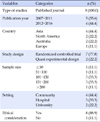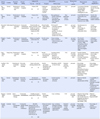1. Jung SH. Socioeconomic burden of suicide and depression in South Korea. Research paper. Seoul: Ewha Womans University;2005.
2. OECD. Health at a glance 2015 OECD indicators. Paris: OECD Publishing;2015. p. 216. DOI:
10.1787/47801564-en.
3. Bertolote JM, Fleischmann A, Leo DD, Wasserman D. Psychiatric diagnoses and suicide: revisiting the evidence. Crisis. 2004; 25(4):147–155. DOI:
10.1027/0227-5910.25.4.147.

5. Chagnon F, Houle J, Marcoux I, Renaud J. Control-group study of an intervention training program for youth suicide prevention. Suicide Life Threat Behav. 2007; 37(2):135–144. DOI:
10.1521/suli.2007.37.2.135.

6. Feldman MD, Franks P, Duberstein PR, Epstein R, Kravitz RL. Let's not talk about it: suicide inquiry in primary care. Ann Fam Med. 2007; 5(5):412–418. DOI:
10.1370/afm.719.

7. Wu CY, Lin YY, Yeh MC, Huang LH, Chen SJ, Liao SC, et al. Effectiveness of interactive discussion group in suicide risk assessment among general nurses in Taiwan: a randomized controlled trial. Nurse Educ Today. 2014; 34(11):1388–1394. DOI:
10.1016/j.nedt.2014.03.015.

10. Tsai WP, Lin LY, Chang HC, Yu LS, Chou MC. The effects of the gatekeeper suicide-awareness program for nursing personnel. Perspect Psychiatr Care. 2011; 47(3):117–125. DOI:
10.1111/j.1744-6163.2010.00278.x.

11. Chan SW, Chien WT, Tso S. Provision and evaluation of a suicide prevention and management programme by frontline nurses in Hong Kong. Hong Kong Med J. 2009; 15:Suppl 6. 4–8.
12. Jung IW, Yang S. Emotional reaction of psychiatric nurses and resident physicians toward suicidal behavior in psychiatric inpatients. J Korean Acad Psychiatr Ment Health Nurs. 2011; 20(4):365–375. DOI:
10.12934/jkpmhn.2011.20.4.365.

13. Ghoncheh R, Gould MS, Twisk JW, Kerkhof AJ, Koot HM. Efficacy of adolescent suicide prevention e-learning modules for gatekeepers: a randomized controlled trial. JMIR Ment Health. 2016; 3(1):e8. DOI:
10.2196/mental.4614.

14. Luebbert R, Popkess A. The influence of teaching method on performance of suicide assessment in baccalaureate nursing students. J Am Psychiatr Nurses Assoc. 2015; 21(2):126–133. DOI:
10.1177/1078390315580096.

15. Simpson G, Franke B, Gillett L. Suicide prevention training outside the mental health service system: evaluation of a statewide program in Australia for rehabilitation and disability staff in the field of traumatic brain injury. Crisis. 2007; 28(1):35–43. DOI:
10.1027/0227-5910.28.1.35.

16. Donald M, Dower J, Bush R. Evaluation of a suicide prevention training program for mental health services staff. Community Ment Health J. 2013; 49(1):86–94. DOI:
10.1007/s10597-012-9489-y.

17. Kim SY, Park JE, Seo HJ, Lee YJ, Jang BH, Son HJ, et al. NECA Systematic review manual. NECA research methodology series. NECA;2011. p. 287.
18. Lee YJ. Development of the education programs on suicide prevention for the physicians and the health care providers. Service Report. National Center for Mental Health;2011. 10.
19. Jo HK. Nurses' experience of the suicide of inpatients [dissertation]. [Seoul]: Ehwa Womans University;2010. 184.
20. Lee GS, Ko JS, Kim JK, Yoon SJ, Lee HJ, Lee MS. A study on effects of the gatekeeper training in Seoul. Ment Health. 2014; 5:79–85.
22. Sun FK, Long A, Huang XY, Chiang CY. A quasi-experimental investigation into the efficacy of a suicide education programme for second-year student nurses in Taiwan. J Clin Nurs. 2011; 20(5-6):837–846. DOI:
10.1111/j.1365-2702.2010.03503.x.

23. Wyman PA, Brown CH, Inman J, Cross W, Schmeelk-Cone K, Guo J, et al. Randomized Trial of a gatekeeper program for suicide prevention: 1-year impact on secondary schoolstaff. J Consult Clin Psychol. 2008; 76(1):104–115. DOI:
10.1037/0022006x.76.1.104.

24. Rihmer Z, Rutz W, Pihlgren H. Depression and nurses' experience of the suicide of inpatients suicide on Gotland an intensive study of all suicides before and after a depression-training programme for general practitioners. J Affec Disord. 1995; 35(4):147–152. DOI:
10.1016/0165-0327(95)00055-0.

25. Kim MS. The effect of suicide prevention programs; a metaanalytic review. Korean J Soc Welf Res. 2012; 30:27–56.
26. Park H, Bae JY. Efficient suicide prevention intervention: metaanalysis. J Korean Acad Psychiatr Ment Health Nurs. 2013; 22(4):273–284. DOI:
10.12934/jkpmhn.2013.22.4.273.






 PDF
PDF ePub
ePub Citation
Citation Print
Print





 XML Download
XML Download